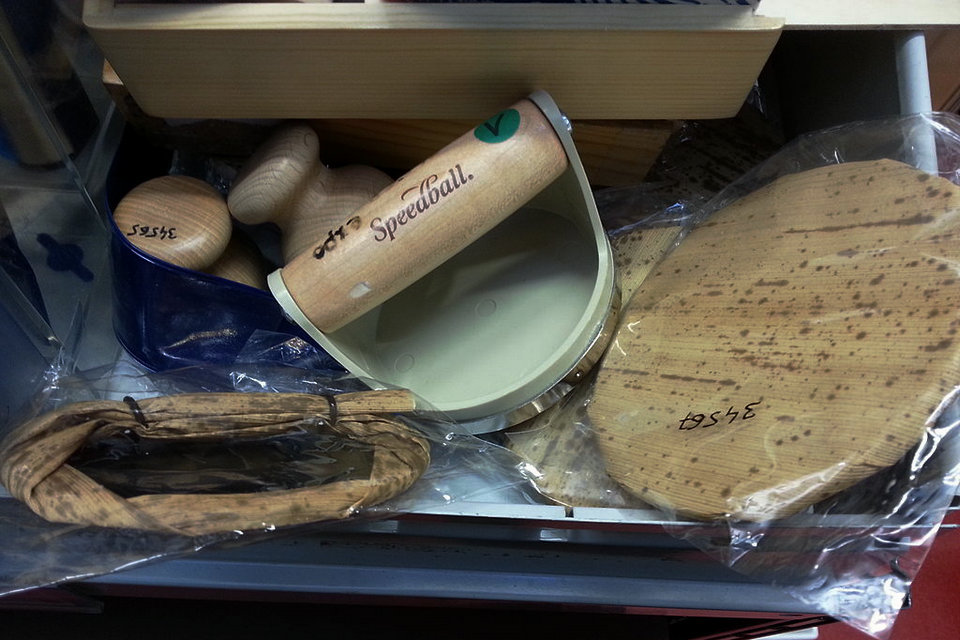Baren (馬連、馬楝) is a disk-like hand tool with a flat bottom and a knotted handle used in Japanese woodblock printing. It is used to burnish (firmly rub) the back of a sheet of paper, lifting ink from the block.
A Baren is a tool used to print woodblock prints. It is also described as a horse ream or a mat. Using a twisted cord made of bamboo skin and the like as a core, a large amount of paper is layered on a lacquer-coated round plate-shaped skin (addressed to a horse) to improve sliding. This is wrapped in bamboo skin and made.
In some cases, camellia oil is applied to improve the slip and not to damage the paper. Some ukiyo-e print masters rub their cheeks and heads.
By rubbing the paper spine against the block, ink and paint applied to the block are attached to the paper and printing is performed.
The main use is to use the index finger, middle finger and ring finger through the grip part.
In China
In China, where the oldest traces of printing appeared, the frotton, called mobang ( Chinese: 磨棒) is in the form of an oblong object, corresponding to the width of the page and, which allows printing in one pass. The ink used is water-based, which passes without too much pressure on the paper.
In Japan
The baren is a flat disc, with a braided handle. It is rubbed on the sheet placed on the previously inked matrix, which makes it possible to keep only the ink placed on the non-hollowed patterns (reserve engraving, such as ukiyo-e ).
The baren can be made of folded and braided bamboo sheets or, more recently, of plastic.
Construction
The baren is made of layers. A flat coil of braided cord forms the core. This is placed on a disk (ategawa) consisting of 30–40 sheets of high-grade long-fibred hosokawa paper, wrapped in tissue and black lacquer. This is covered by a thin bamboo sheath (takenokawa) twisted in such a manner as to form the handle on the top. According to Hiroshi Yoshida’s manual Japanese Woodblock Printing (1939) the madake species of bamboo, grown in Kyushu, southwest Japan, is considered the best one to use.
The bamboo-sheath covering the baren may need to be renewed after a day’s printing. Rewrapping requires great skill; a printer’s ability is sometimes judged by their competence carrying out this work.
The disk inside the baren takes 40–50 days to create, as the craftsman glues one sheet of paper on the disk each day. The disk must then dry for a year before the baren is assembled. The coil and covering of the baren are woven and formed from parts of the bamboo plant, requiring the skill of a true master. Only one known person in Japan is still making traditional (hon) baren for a living — Hidehiko Goto of the Kikuhide workshop.
Alternatives
Large wooden spoons are also used as burnishing tools in printmaking, glass jars with a smooth circular base can also be used for some applications. Some new world barens are similar in shape to the traditional one with small metal ball bearings embedded in the bottom surface that generate the high point contact pressures (supplied by the braided cord) and have the low friction (offered by the bamboo leaf covering) of a traditional brayer. Another interesting baren is one developed by Professor Seishi Ozakus and made from a bundle of bamboo toothpicks.
Nik Semenoff has developed a palm press that serves as a baren replacement, made with a number of roller bearings alternating on two close spaced shafts in a small hand held mounting. The bearings have negligible friction and the pressures achievable are suitable for some offset lithography printing, though wider spacing of fewer contact points may make it less suited for traditional wood cut printing.
